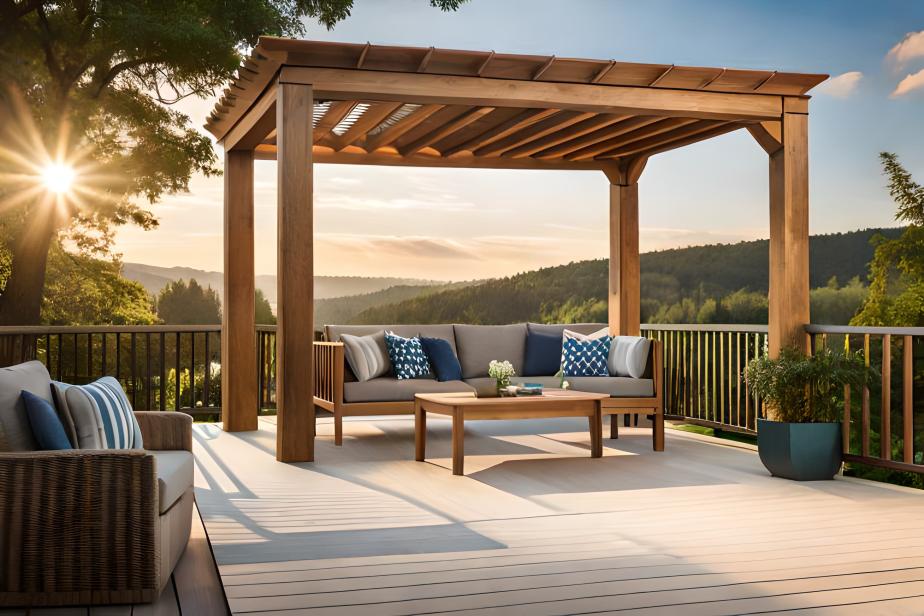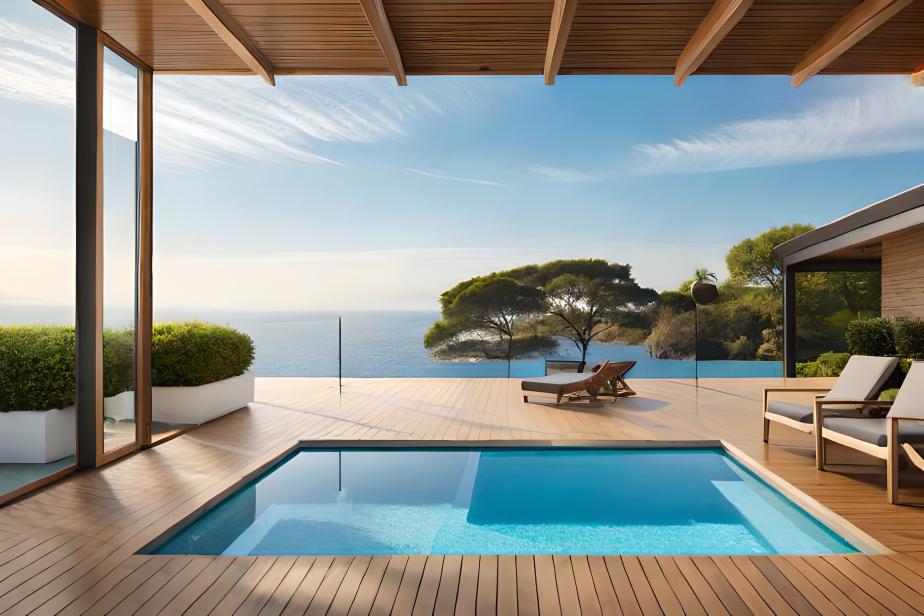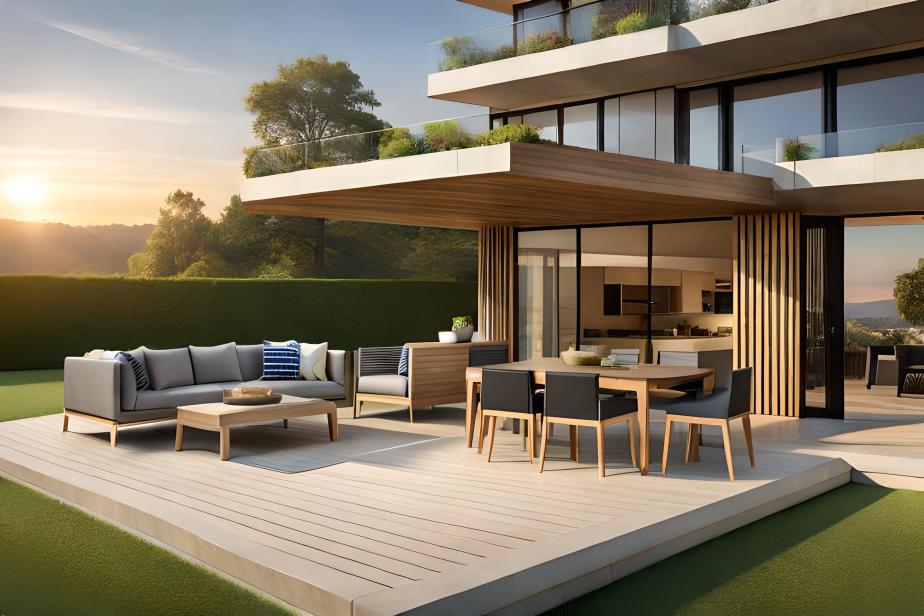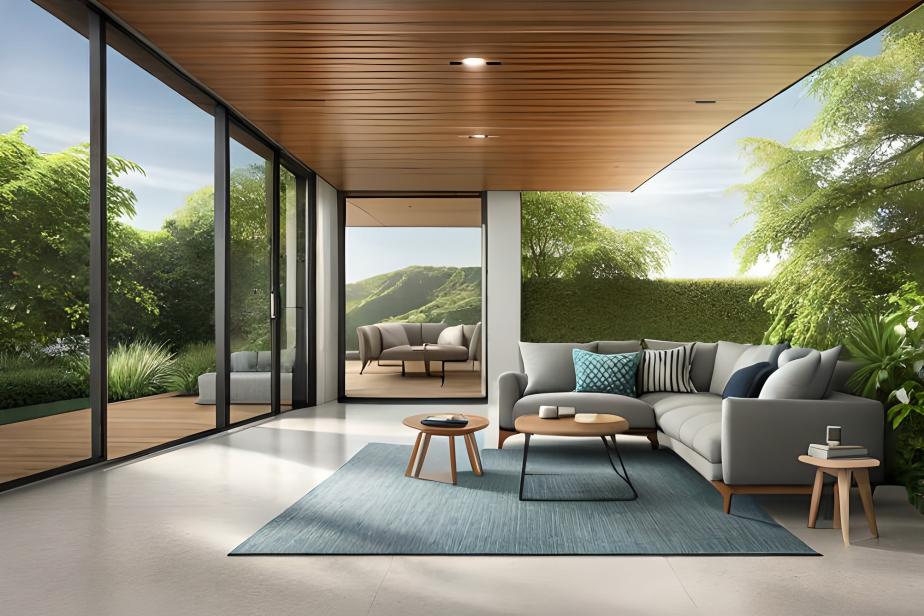Are you looking to transform your outdoor space into a beautiful, functional area for relaxation and entertainment? A freestanding deck might be the perfect solution. Unlike attached decks, freestanding decks are not connected to a house or any other structure, allowing you to design and build them anywhere in your yard. In this comprehensive guide, we’ll explore innovative freestanding deck design ideas and provide practical tips for planning and construction.

What is a Freestanding Deck?
A freestanding deck, also known as a floating or detached deck, is a platform that stands independently of a house or other structures. Its set of posts and footings supports it, making it versatile and adaptable to various landscapes, including sloped or uneven ground. Freestanding decks can be designed in any shape or size, allowing for a high degree of customization to suit your specific needs and preferences.
Why Choose a Freestanding Deck?
Choosing a freestanding deck comes with several benefits. First, it provides flexibility in terms of location. You can build it anywhere in your yard, whether near your house, by the pool, or in a secluded corner for privacy. Second, it’s an excellent solution for homes with non-traditional architecture or siding materials that may not support an attached deck. Lastly, building a freestanding deck can be more straightforward as it often doesn’t require the same permits and inspections as an attached deck.
Planning Your Freestanding Deck
Before diving into the design ideas, planning your freestanding deck carefully is essential. Consider the deck’s purpose, the size and shape that would best fit your yard, and the materials you want to use. Check local building codes to ensure your deck design complies with any regulations. If planning a large or high deck, you may need to consider additional bracing or support.

Innovative Freestanding Deck Design Ideas
Now, let’s explore some innovative freestanding deck design ideas to inspire your project:
- Garden Oasis
A freestanding deck in the garden can be a great way to create a peaceful oasis. Surround the patio with lush plants and flowers to create a serene, natural setting. You can also add a water feature, such as a fountain or pond, to enhance the peaceful atmosphere.
Here are some specific design ideas for a garden oasis deck:
- Use natural materials, such as wood, stone, and bamboo, for the deck and railings.
- Plant native plants and flowers that will attract butterflies and birds.
- Add a water feature like a fountain or pond to create a calming soundscape.
- Install string lights or lanterns to create a romantic atmosphere at night.
- Poolside Deck
A freestanding deck can be a great way to extend your poolside space. Add comfortable seating, a sun umbrella, and a small table to create a relaxing poolside oasis. You can also add a fire pit for enjoying warm evenings by the pool.
Here are some specific design ideas for a poolside deck:
- Use a light-colored decking material to reflect the sun’s rays and keep the balcony cool.
- Add a pergola or awning to provide shade from the sun.
- Install a built-in barbecue or grill for cooking outdoors.
- Place comfortable seating in a shady spot for relaxing by the pool.
- Multi-Level Deck
A multi-level deck can be a great way to create a more dynamic and functional space. Each level can serve a different purpose, such as dining, lounging, or cooking. For example, you could have a lower level for dining and an upper deck for lounging or sunbathing.
Here are some specific design ideas for a multi-level deck:
- Use different decking materials on each level to create visual interest.
- Add stairs or ramps to connect the other groups.
- Include built-in seating or planters on each deck.
- Use railings or fences to create privacy and safety.
- Deck with Pergola
A pergola is a great way to add shade and visual interest to your freestanding deck. You can hang lights from the pergola to create a cozy, enchanting atmosphere. You can also grow climbing plants on the arbor to add privacy and greenery.
Here are some specific design ideas for a deck with a pergola:
- Use a pergola with a latticework design to allow light to filter through.
- Hang lanterns or string lights from the pergola to create a romantic nighttime atmosphere.
- Grow climbing plants, such as vines or roses, on the arbor to add privacy and greenery.
- Outdoor Dining Deck
If you love entertaining, an outdoor dining deck is a great way to extend your living space. Include a dining table, chairs, and a grill or outdoor kitchen for the perfect outdoor dining experience. You can also add a bar or counter for seating and prep space.
Here are some specific design ideas for an outdoor dining deck:
- Use a large dining table to accommodate a crowd.
- Include a built-in grill or outdoor kitchen for cooking outdoors.
- Add comfortable seating, such as benches or chairs, for lounging.
- Use a pergola or awning to provide shade from the sun.
- Deck with Built-In Seating
Built-in seating is a great way to maximize your deck’s functionality. This can be in benches along the edges or even sunken seating areas. Built-in seating can also provide additional storage space.
Here are some specific design ideas for a deck with built-in seating:
- Include benches along the edges of the deck for additional seating.
- Build a sunken seating area for a more intimate space.
- Use built-in seating to create storage space for outdoor cushions, toys, or tools.
- Deck with Fire Pit
A fire pit is a great way to extend your outdoor living space into the cooler months. Gather around the fire pit with family and friends for cozy evenings under the stars. You can roast marshmallows or hot dogs over the fire pit for a fun and festive atmosphere.
Here are some specific design ideas for a deck with a fire pit:
- Choose a fire pit that is the right size for your deck.
- Place the fire pit in a safe location away from any combustible materials.
- Add seating around the fire pit for comfortable lounging.
- Use fire pit accessories like fire rings or screens to keep the fire safe.
Step-by-Step Guide to Building a Freestanding Deck
Building a freestanding deck requires careful planning and execution. Here’s a step-by-step guide to help you through the process:
- Layout & Prepare the Deck Site
- Choose a level location for your deck that is free of obstructions.
- Mark out the area using stakes and string.
- Clear the area of any grass, rocks, or debris.
- If your deck is over 30 inches above the ground, you must mustin a building permit from your local government.
- Dig Concrete Footing Holes
- The spacing and depth of the footing holes will depend on the size of your deck and your local building codes.
- The footings should be at least 4 inches below the frost line.
- The holes should be large enough to accommodate the post anchors.
- Pour the Concrete Footings
- Fill the holes with concrete, ensuring that it is level.
- Insert the post anchors into the concrete before it sets.
- Allow the concrete to cure for at least 24 hours before moving on to the next step.
- Install the Posts
- Attach the posts to the post anchors using galvanized hardware.
- Use a level to ensure that the posts are straight.
- If your deck is over 3 feet high, install diagonal bracing to prevent the posts from swaying.
Build the Beam
- The beam is the primary support for the deck joists.
- It is typically made from two pieces of 2×10 or 2×12 lumber.
- Attach the pieces of lumber using galvanized hardware.
- Attach the beam to the posts using galvanized hardware.
- Set the Beam
- Position the beam on the posts, ensuring it is level and secure.
- Use shims under the beam as needed to level it.
- Install the Floor Joists
- The joists are the horizontal beams that support the deck boards.
- They are typically spaced 16 inches in the center.
- Attach the joists to the beam using joist hangers.
- Lay the Deck Boards
- The deck boards are the top layer of the deck.
- They are typically made from pressure-treated lumber.
- Lay the boards across the joists, starting from one end of the deck.
- Secure each board with screws.
- Install Steps & Railings
- If your deck is high off the ground, you must install steps for access.
- Depending on the height of your deck and local building codes, you may also need to install railings for safety.
- Finishing Touches
- Once the deck is built, you can stain or paint it to protect it from the elements.
- You can add furniture, plants, and other decorations to make your deck comfortable and inviting.
Remember, building a deck is a significant project that requires a good understanding of construction principles. If you’re not comfortable doing it yourself, consider hiring a professional.

Tips and Considerations for Building a Freestanding Deck
When building a freestanding deck, keep the following information and considerations in mind:
- Check Local Building Codes
Before building your deck, you must check with your local building department to understand the codes and regulations you must follow. This will vary depending on where you live, but there are typically requirements for deck height, footing depth, and railings. You may also need to obtain a permit to build your deck.
- Choose the Right Materials
The materials you choose for your deck will affect its appearance, durability, and maintenance requirements. Common choices include pressure-treated lumber, cedar, redwood, and composite decking.
- Pressure-treated lumber is a good choice for decks exposed to the elements. It is treated with chemicals to resist rot and decay.
- Cedar is a naturally rot-resistant wood that is also attractive and durable.
- Redwood is another naturally rot-resistant wood that is also very strong.
- Composite decking is made from a combination of wood and plastic. It is resistant to rot, decay, and moisture and requires less maintenance than traditional wood decking.
- Plan for Drainage
It’s essential to plan for drainage when building a deck. This will help to prevent water from pooling on the deck surface, which can lead to rot and decay.
- The deck should be sloping away from the house to allow water to drain off.
- For proper drainage, the joists should be spaced at least 16 inches in the center.
- The deck boards should be spaced 1/8 to 1/4 inch apart to allow water to drain.
- Consider the Sun and Wind
The sun’s direction and prevailing winds should be considered when choosing the location for your deck. You may want to position your deck in a shaded area or add a pergola or other shade structure.
- If your deck is in a sunny location, you may want to choose a material resistant to fading.
- If your deck is in a windy location, you may want to choose a strong and durable material.
- Safety First
If your deck is more than a few feet off the ground, it should have railings for safety. The bars should be at least 36 inches high and have a spacing of no more than 4 inches.
- The railings should be made from a strong material, such as pressure-treated lumber or composite decking.
- The railings should be securely attached to the deck posts.
- Other Considerations
In addition to the tips and considerations above, there are a few other things to keep in mind when building a freestanding deck:
- The size of your deck will depend on your needs and the space available in your yard.
- The shape of your deck can be simple or complex.
- You may want to add features to your deck, such as a built-in barbecue, a hot tub, or a pergola.
Building a freestanding deck can be a challenging but rewarding project. Following these tips and considerations can create a safe and beautiful addition to your home.
Conclusion
A freestanding deck can be a beautiful and functional addition to your outdoor space. With careful planning and design, you can create a deck that suits your needs and enhances your outdoor living experience. The possibilities are endless, whether looking for a peaceful garden retreat, a poolside lounge, or a dynamic multi-level deck.
FAQ about Freestanding Decks
How do you plan a freestanding deck? Planning a freestanding deck involves choosing the location, determining the size and shape, selecting the materials, and designing the layout. You should also check local building codes and obtain any necessary permits.
Do freestanding decks need footings? Yes, freestanding decks need bases to support the deck posts. The grounds are typically concrete and should be set below the frost line to prevent shifting during freeze-thaw cycles.
What is the max height for a freestanding deck? The maximum size for a freestanding deck will depend on your local building codes. However, as a general rule, any deck over 30 inches above ground level will require railings for safety.
What is the spacing for freestanding deck footings? The spacing for freestanding deck footings will depend on the size and weight of your deck and the type of soil. As a general guideline, floors are typically spaced 6 to 8 feet apart.
Building a freestanding deck is a rewarding project that can enhance your outdoor living space and increase the value of your home. With the proper planning, design, and construction, you can create a beautiful and functional deck that you and your family can enjoy for years.
For more information and inspiration, check out these resources:
- Freestanding Decks | JLC Online
- How to Build a Freestanding Deck | Decks.com by Trex
- Everything You Need to Know About Building a Freestanding Deck | Better Homes & Gardens
- 13 Floating Deck Ideas Perfect for Big or Small Backyards – Bob Vila
- 12 DIY Floating Deck Ideas – Backyard Decorating Ideas | Country Living
Remember, whether you’re a DIY enthusiast or prefer to hire professional, careful planning and design are critical to a successful deck project. Happy building!
“Building a freestanding deck was one of our best decisions for our home. We worked with a professional to design a multi-level deck with a built-in seating area and pergola. It’s become our favorite spot for family gatherings and summer barbecues. The process was smooth, and the result exceeded our expectations. I highly recommend considering a freestanding deck for anyone looking to enhance their outdoor space.” – Sarah and John Thompson, Homeowners in Austin, Texas.

